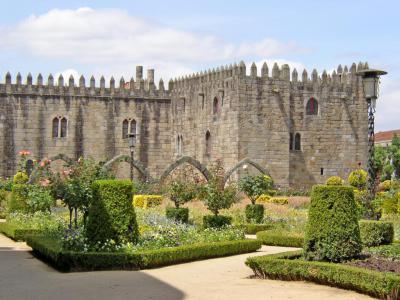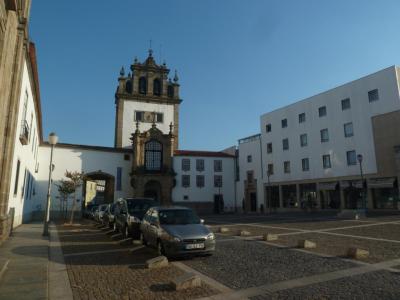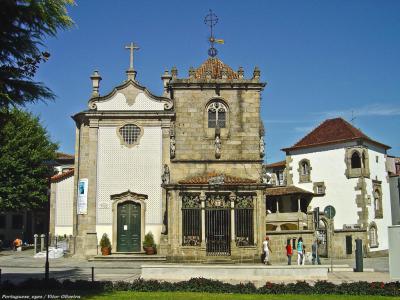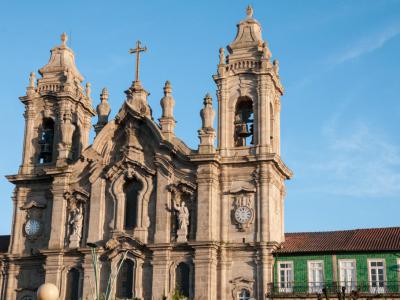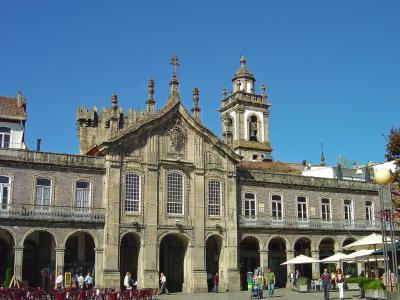
Historical Religious Sites Walking Tour (Self Guided), Braga
Braga is a prominent destination in Portugal's Religious Tourism segment, primarily due to its vibrant Holy Week celebrations and rich ecclesiastical architecture. Indeed, being one of the world's oldest Christian cities, Braga boasts an extensive religious legacy. Much like Rome, it seamlessly interweaves art and spirituality throughout its historic center.
Here, you will find a multitude of old religious sites that have played a significant role in shaping the city's identity. One such is the Episcopal Palace, an architectural gem that served as the residence of the archbishops of Braga for centuries.
Another notable sight is the Braga Compassion Church (Igreja da Misericordia de Braga) renowned for its ornate interior and beautiful altarpieces.
The Braga Cathedral (Se de Braga) is one of the oldest cathedrals in Portugal. Its imposing Gothic appearance and intricate decorations make it a symbol and center of Braga's religious heritage.
The Chapel of Our Lady of the Tower is another religious landmark, known for its serene ambiance and historical significance.
The Church of Holy Cross (Igreja de Santa Cruz) is an architectural marvel with intricate artwork and serene atmosphere making it a peaceful place for contemplation.
The Coimbras Chapel (Capela dos Coimbras) is a hidden gem within Braga, known for its exquisite tilework and historical significance.
The Basilica of the Congregants (Basilica dos Congregados), with its grand facade and interior, is a sight to behold, attracting visitors from all over the world.
Last but not least, the Church of Lapa is an architectural beauty whose religious significance makes it a must-visit site for those exploring Braga's religious history.
During Holy Week, the liturgical observances take on a special grandeur in Braga, with notable events such as the street processions, the Cathedral's solemn ceremony, and others getting underway. Throughout this week, the city welcomes thousands of devout pilgrims from across the country and abroad, elevating its status as a significant point of interest for tourists. If you're interested in the spiritual and historical aspects of Braga, our self-guided tour will come in handy for you any time of the year. Just put on your comfortable shoes and enjoy the walk!
Here, you will find a multitude of old religious sites that have played a significant role in shaping the city's identity. One such is the Episcopal Palace, an architectural gem that served as the residence of the archbishops of Braga for centuries.
Another notable sight is the Braga Compassion Church (Igreja da Misericordia de Braga) renowned for its ornate interior and beautiful altarpieces.
The Braga Cathedral (Se de Braga) is one of the oldest cathedrals in Portugal. Its imposing Gothic appearance and intricate decorations make it a symbol and center of Braga's religious heritage.
The Chapel of Our Lady of the Tower is another religious landmark, known for its serene ambiance and historical significance.
The Church of Holy Cross (Igreja de Santa Cruz) is an architectural marvel with intricate artwork and serene atmosphere making it a peaceful place for contemplation.
The Coimbras Chapel (Capela dos Coimbras) is a hidden gem within Braga, known for its exquisite tilework and historical significance.
The Basilica of the Congregants (Basilica dos Congregados), with its grand facade and interior, is a sight to behold, attracting visitors from all over the world.
Last but not least, the Church of Lapa is an architectural beauty whose religious significance makes it a must-visit site for those exploring Braga's religious history.
During Holy Week, the liturgical observances take on a special grandeur in Braga, with notable events such as the street processions, the Cathedral's solemn ceremony, and others getting underway. Throughout this week, the city welcomes thousands of devout pilgrims from across the country and abroad, elevating its status as a significant point of interest for tourists. If you're interested in the spiritual and historical aspects of Braga, our self-guided tour will come in handy for you any time of the year. Just put on your comfortable shoes and enjoy the walk!
How it works: Download the app "GPSmyCity: Walks in 1K+ Cities" from Apple App Store or Google Play Store to your mobile phone or tablet. The app turns your mobile device into a personal tour guide and its built-in GPS navigation functions guide you from one tour stop to next. The app works offline, so no data plan is needed when traveling abroad.
Historical Religious Sites Walking Tour Map






Guide Name: Historical Religious Sites Walking Tour
Guide Location: Portugal » Braga (See other walking tours in Braga)
Guide Type: Self-guided Walking Tour (Sightseeing)
# of Attractions: 8
Tour Duration: 1 Hour(s)
Travel Distance: 1.4 Km or 0.9 Miles
Author: nataly
Sight(s) Featured in This Guide:
Guide Location: Portugal » Braga (See other walking tours in Braga)
Guide Type: Self-guided Walking Tour (Sightseeing)
# of Attractions: 8
Tour Duration: 1 Hour(s)
Travel Distance: 1.4 Km or 0.9 Miles
Author: nataly
Sight(s) Featured in This Guide:
- Episcopal Palace
- Igreja da Misericordia de Braga (Braga's Compassion Church)
- Se de Braga (Braga Cathedral)
- Chapel of Our Lady of the Tower
- Igreja de Santa Cruz (Church of Holy Cross)
- Capela dos Coimbras (Coimbras Chapel)
- Basilica dos Congregados (Basilica of the Congregants)
- Church of Lapa
1) Episcopal Palace (must see)
The Episcopal Palace was once the residence of the archbishops of Braga, a position of great importance in the region's ecclesiastical hierarchy.
The origins of the Bishopric of Bracara date back to 388 when it was founded by Paternus, who became its first bishop. Officially, the archbishopric of Braga was established in 1071, with D. Pedro serving as its first archbishop. The political landscape in Braga evolved as well, with Count D. Henrique and Countess D. Teresa holding sway over the city between 1096 and 1112. In 1112, a significant letter was issued, donating the city to the archbishops and instituting an ecclesiastical fiefdom that would persist until the 18th century.
The Episcopal Palace comprises three distinct buildings, each representing different architectural styles: Gothic, Renaissance, and Baroque. These buildings are interconnected, resulting in an irregular and asymmetrical composition.
The medieval portion of the palace is associated with a rectangular garden patio that faces the Garden of Santa Bárbara. This section is characterized by its Gothic features. The 15th-century U-shaped wing connects to the medieval structure and is oriented toward the rectangular square known as Largo do Paço. The Baroque Wing, facing Largo do Município, represents the most formal and symmetrical section of the palace. It features a three-register structure with a recessed central body and lateral wings.
In 1911, the archbishop was expelled from the palace, leading to its occupation by the military and fire brigade. During the 1930s, the palace underwent renovations to transform it into a public library and archive. Today, it houses the Biblioteca Pública de Braga, local archives, and offices of the University of Minho.
The origins of the Bishopric of Bracara date back to 388 when it was founded by Paternus, who became its first bishop. Officially, the archbishopric of Braga was established in 1071, with D. Pedro serving as its first archbishop. The political landscape in Braga evolved as well, with Count D. Henrique and Countess D. Teresa holding sway over the city between 1096 and 1112. In 1112, a significant letter was issued, donating the city to the archbishops and instituting an ecclesiastical fiefdom that would persist until the 18th century.
The Episcopal Palace comprises three distinct buildings, each representing different architectural styles: Gothic, Renaissance, and Baroque. These buildings are interconnected, resulting in an irregular and asymmetrical composition.
The medieval portion of the palace is associated with a rectangular garden patio that faces the Garden of Santa Bárbara. This section is characterized by its Gothic features. The 15th-century U-shaped wing connects to the medieval structure and is oriented toward the rectangular square known as Largo do Paço. The Baroque Wing, facing Largo do Município, represents the most formal and symmetrical section of the palace. It features a three-register structure with a recessed central body and lateral wings.
In 1911, the archbishop was expelled from the palace, leading to its occupation by the military and fire brigade. During the 1930s, the palace underwent renovations to transform it into a public library and archive. Today, it houses the Biblioteca Pública de Braga, local archives, and offices of the University of Minho.
2) Igreja da Misericordia de Braga (Braga's Compassion Church)
The Compassion Church is a significant religious edifice with a history dating back to the 16th century. While it was originally constructed in 1562, it underwent substantial modifications in the 19th century.
Architecturally, the Compassion Church presents a relatively simple yet elegant facade, showcasing elements of Renaissance architecture. The side portal, in particular, stands out as a remarkable feature. At its apex, there is a depiction of the "Visitation," a scene that is attributed to the skilled artisans of the 16th-century Coimbra sculpture school.
Inside the church, visitors are greeted with a baroque carved altarpiece, a notable feature of the interior. The altarpiece is a masterpiece created by Marcelino de Araújo between 1734 and 1739. It includes a painted panel from 1735 by the artist José Lopes. While the altarpiece has religious themes, it also incorporates courtly characteristics, featuring depictions of several family members of D. João V, the Queen, and her children. Dominating the main altar is an image of Our Lady of Mercy, sculpted by José António Gonçalves in 1774.
Architecturally, the Compassion Church presents a relatively simple yet elegant facade, showcasing elements of Renaissance architecture. The side portal, in particular, stands out as a remarkable feature. At its apex, there is a depiction of the "Visitation," a scene that is attributed to the skilled artisans of the 16th-century Coimbra sculpture school.
Inside the church, visitors are greeted with a baroque carved altarpiece, a notable feature of the interior. The altarpiece is a masterpiece created by Marcelino de Araújo between 1734 and 1739. It includes a painted panel from 1735 by the artist José Lopes. While the altarpiece has religious themes, it also incorporates courtly characteristics, featuring depictions of several family members of D. João V, the Queen, and her children. Dominating the main altar is an image of Our Lady of Mercy, sculpted by José António Gonçalves in 1774.
3) Se de Braga (Braga Cathedral) (must see)
The Sé de Braga showcases a blend of architectural styles that reflect the cathedral's long and varied history. While its origins date back to the 11th century, subsequent renovations and additions have contributed to its unique appearance.
The original structure of the Sé de Braga was primarily Romanesque, characterized by its robust, fortress-like design. Visitors can admire the Romanesque façade with its intricate sculptural details, including biblical scenes and figures.
In the 14th century, significant Gothic renovations were carried out on the cathedral, contributing to its soaring pointed arches, ribbed vaults, and large stained glass windows. These Gothic elements add to the grandeur and grace of the cathedral's interior.
The interior of the Sé de Braga also features Baroque elements, including ornate altarpieces, gilded woodwork, and decorative motifs. The Baroque Chapel of the Kings (Capela dos Reis) is a notable highlight, adorned with beautifully crafted sculptures and intricate decorations.
The Sé de Braga boasts a unique Manueline-style chapel, characterized by its maritime-inspired details, such as ropes, shells, and seaweed motifs.
The cathedral also features a stunning cloister, built in the 14th century. This peaceful courtyard is adorned with Gothic and Manueline elements and provides visitors with an opportunity to appreciate the intricate craftsmanship of the period.
The Sé de Braga remains an active place of worship and is a significant pilgrimage site for Catholics in Portugal. Today, the Sé de Braga welcomes visitors who can explore its historic interior, marvel at its architectural features, and soak in the atmosphere of this sacred place.
The original structure of the Sé de Braga was primarily Romanesque, characterized by its robust, fortress-like design. Visitors can admire the Romanesque façade with its intricate sculptural details, including biblical scenes and figures.
In the 14th century, significant Gothic renovations were carried out on the cathedral, contributing to its soaring pointed arches, ribbed vaults, and large stained glass windows. These Gothic elements add to the grandeur and grace of the cathedral's interior.
The interior of the Sé de Braga also features Baroque elements, including ornate altarpieces, gilded woodwork, and decorative motifs. The Baroque Chapel of the Kings (Capela dos Reis) is a notable highlight, adorned with beautifully crafted sculptures and intricate decorations.
The Sé de Braga boasts a unique Manueline-style chapel, characterized by its maritime-inspired details, such as ropes, shells, and seaweed motifs.
The cathedral also features a stunning cloister, built in the 14th century. This peaceful courtyard is adorned with Gothic and Manueline elements and provides visitors with an opportunity to appreciate the intricate craftsmanship of the period.
The Sé de Braga remains an active place of worship and is a significant pilgrimage site for Catholics in Portugal. Today, the Sé de Braga welcomes visitors who can explore its historic interior, marvel at its architectural features, and soak in the atmosphere of this sacred place.
4) Chapel of Our Lady of the Tower
The Chapel of Our Lady of the Tower marks one of the medieval lookout points and served as one of the entrances to the city of Braga.
The Santiago Tower, where the chapel is situated, still maintains its medieval appearance, creating a striking contrast with the rocaille (rococo) decoration that adorns the North façade. The façade is divided into two distinct registers: The Upper Register is characterized by the presence of a stone clock and a bell tower, which are prominent architectural features of the tower. The Lower Register of the façade is where you will find the Oratory of Nossa Senhora da Torre. This oratory was added to the tower in the 17th century, during the Baroque period, and serves as a place of worship.
The chapel was designed by the renowned architect André Soares, and its construction was initiated as an expression of gratitude to the Virgin Mary. It was dedicated to Our Lady of the Tower as a token of appreciation for her protection during the devastating Great Lisbon Earthquake of 1755, which caused widespread destruction throughout Portugal.
The chapel's location to the north faces Largo de São Paulo, a square bordered by the imposing building of the Jesuit College of Santiago. The chapel shares a direct connection with the college.
The Santiago Tower, where the chapel is situated, still maintains its medieval appearance, creating a striking contrast with the rocaille (rococo) decoration that adorns the North façade. The façade is divided into two distinct registers: The Upper Register is characterized by the presence of a stone clock and a bell tower, which are prominent architectural features of the tower. The Lower Register of the façade is where you will find the Oratory of Nossa Senhora da Torre. This oratory was added to the tower in the 17th century, during the Baroque period, and serves as a place of worship.
The chapel was designed by the renowned architect André Soares, and its construction was initiated as an expression of gratitude to the Virgin Mary. It was dedicated to Our Lady of the Tower as a token of appreciation for her protection during the devastating Great Lisbon Earthquake of 1755, which caused widespread destruction throughout Portugal.
The chapel's location to the north faces Largo de São Paulo, a square bordered by the imposing building of the Jesuit College of Santiago. The chapel shares a direct connection with the college.
5) Igreja de Santa Cruz (Church of Holy Cross)
The Church of Holy Cross was commissioned by Jerónimo Portilo, the founder of the Order of the Holy Cross, who was later granted the title of Royal Fellow by King João VI (1816-1826). Construction of the church commenced in 1625 and was only completed in 1737, resulting in a unique fusion of both Mannerist and Baroque architectural elements.
The church's façade bears distinctive features, most notably the architrave crowning the three main entrance doors, which displays thirteen instruments symbolizing Christ's passion, including the crown of thorns, the carnations, the whip, and the gall sponge, among others.
The church's exterior is marked by two bell towers flanking the façade, each incorporating clocks. These bell towers are renowned for their ornate decoration, attributed to the master bricklayer Francisco Álvares.
Upon entering the church, visitors are greeted by a spacious interior with side chapels, separated by arches and adorned with splendid carved altars. These altars house valuable relics of various saints, adding to the cultural and spiritual significance of the church.
The church's interior boasts intricately detailed stone vaults and high-quality craftsmanship, particularly in the organ and pulpits. Additionally, the church showcases remarkable gilded carvings completed in the 18th century, further enhancing its aesthetic appeal. Legend has it that there are three carved roosters on the church door, although only two are visible.
The church's façade bears distinctive features, most notably the architrave crowning the three main entrance doors, which displays thirteen instruments symbolizing Christ's passion, including the crown of thorns, the carnations, the whip, and the gall sponge, among others.
The church's exterior is marked by two bell towers flanking the façade, each incorporating clocks. These bell towers are renowned for their ornate decoration, attributed to the master bricklayer Francisco Álvares.
Upon entering the church, visitors are greeted by a spacious interior with side chapels, separated by arches and adorned with splendid carved altars. These altars house valuable relics of various saints, adding to the cultural and spiritual significance of the church.
The church's interior boasts intricately detailed stone vaults and high-quality craftsmanship, particularly in the organ and pulpits. Additionally, the church showcases remarkable gilded carvings completed in the 18th century, further enhancing its aesthetic appeal. Legend has it that there are three carved roosters on the church door, although only two are visible.
6) Capela dos Coimbras (Coimbras Chapel)
The construction of the Coimbras Chapel, also known as the Chapel of Our Lady of Conception, dates back to the 16th century, precisely in 1525, under the patronage of João Coimbra, who served as the provisor to Archbishop Diogo de Sousa. João Coimbra's vision led to the creation of this private chapel, initially dedicated to Our Lady of Conception, and it was designed by the skilled craftsmen known as the builders of the Biscainhos Palace. Its architectural significance is underscored by the fact that it was classified as a National Monument in 1910.
Next to the chapel, you can find the former residence of João Coimbra, which still retains its original Manueline features, even though substantial alterations were made to the structure at the beginning of the 20th century. The façade of the residence proudly displays the Coimbra family coat of arms, symbolizing their historical connection to the complex.
The Coimbras Chapel takes the form of a quadrangular tower, divided into two distinct spaces. The galilee, adorned with Manueline ornaments and statuary crafted by Hodart, serves as the entrance to the chapel. Inside, the interior part designed by João de Ruão features the traditional main altar and the coat of arms of D. João de Coimbra.
The chapel's interior is covered by a ribbed vault, and the walls are adorned with tile images that allude to the Book of Genesis. The exterior sculpting was overseen by Hodart, while the main altar and the statue of "the placing of the Lord in the tomb" are attributed to João de Ruão. Additionally, the retable is complemented by 18th-century tile paneling featuring designs depicting the creation of the world, including unique depictions of Adam and Eve.
Next to the chapel, you can find the former residence of João Coimbra, which still retains its original Manueline features, even though substantial alterations were made to the structure at the beginning of the 20th century. The façade of the residence proudly displays the Coimbra family coat of arms, symbolizing their historical connection to the complex.
The Coimbras Chapel takes the form of a quadrangular tower, divided into two distinct spaces. The galilee, adorned with Manueline ornaments and statuary crafted by Hodart, serves as the entrance to the chapel. Inside, the interior part designed by João de Ruão features the traditional main altar and the coat of arms of D. João de Coimbra.
The chapel's interior is covered by a ribbed vault, and the walls are adorned with tile images that allude to the Book of Genesis. The exterior sculpting was overseen by Hodart, while the main altar and the statue of "the placing of the Lord in the tomb" are attributed to João de Ruão. Additionally, the retable is complemented by 18th-century tile paneling featuring designs depicting the creation of the world, including unique depictions of Adam and Eve.
7) Basilica dos Congregados (Basilica of the Congregants)
Basilica of the Congregants is also known as the Convent, College, and Church of the Congregates. Construction of this basilica commenced in the early 18th century during the height of the Baroque architectural style, although by the time it was completed in the 1960s, the architectural trends had shifted from Baroque to Rococo and Neoclassical. The result is a stunning and unique church characterized by a harmonious blend of various architectural influences, both inside and out.
The church's architectural design is credited to the renowned architect André Soares. It boasts two impressive bell towers that rise majestically above the façade, adding to the basilica's grandeur. The façade itself is adorned with two notable statues, crafted by sculptor Manuel Nogueira da Silva, depicting saints Filipe de Nery and Martinho de Dume. These statues were the final additions to the church, completed in 1964, and they contribute to the basilica's visual appeal.
However, it is the interior of the Basilica dos Congregados that truly captivates visitors with its impressive beauty and intricate details. The basilica's interior is flooded with natural light, enhancing the grandeur of its architectural elements. The nave features a false barrel-vaulted roof lined with cork. Throughout the interior, visitors can admire a collection of impressive statues and religious scenes.
One notable feature inside the basilica is the pipe organ, which is adorned with gilded and polychrome carving. Unlike the traditional placement of organs within the choir space, this pipe organ is located on a small side balcony, adding to the basilica's architectural uniqueness.
The church's architectural design is credited to the renowned architect André Soares. It boasts two impressive bell towers that rise majestically above the façade, adding to the basilica's grandeur. The façade itself is adorned with two notable statues, crafted by sculptor Manuel Nogueira da Silva, depicting saints Filipe de Nery and Martinho de Dume. These statues were the final additions to the church, completed in 1964, and they contribute to the basilica's visual appeal.
However, it is the interior of the Basilica dos Congregados that truly captivates visitors with its impressive beauty and intricate details. The basilica's interior is flooded with natural light, enhancing the grandeur of its architectural elements. The nave features a false barrel-vaulted roof lined with cork. Throughout the interior, visitors can admire a collection of impressive statues and religious scenes.
One notable feature inside the basilica is the pipe organ, which is adorned with gilded and polychrome carving. Unlike the traditional placement of organs within the choir space, this pipe organ is located on a small side balcony, adding to the basilica's architectural uniqueness.
8) Church of Lapa
The Church of Lapa is a beautiful neoclassical church, built in the mid-18th century, that forms an integral part of the Arkad buildings on Republic Square.
One of the most notable features of the Church of Lapa is its façade, adorned with intricately carved vases. This decorative façade stands out from the more compact Arkad buildings, making the church easily distinguishable. The façade's neoclassical design reflects the artistic sensibilities of the period.
Stepping inside, visitors are greeted by a stunning interior adorned with 19th-century azulejos tiles. The high-profile choir features a wooden balustrade, showcasing the craftsmanship of the time. An organ also graces the interior, further enhancing the musical and spiritual ambiance of the church.
An additional significant feature of the church is its recessed bell tower, which was erected in 1771. This bell tower stands atop one of the turrets that once belonged to the city's old castle, adding historical depth to the church's architecture.
The history of the Church of Lapa is intertwined with the devotion to Our Lady of Lapa. In 1757, Father Ângelo de Sequeira, a canon of the Cathedral of São Paulo in Brazil, arrived in Braga to preach. He chose the location of the Arkad, which was traditionally used for the sale of foodstuffs in the city, to place an image of Our Lady of Lapa.
In response to the growing devotion, Archbishop D. Gaspar de Bragança of Braga authorized the construction of a chapel dedicated to Our Lady of Lapa. Work on the chapel commenced on September 9, 1761, with the project attributed to the renowned architect André Soares. The temple was consecrated on September 7, 1767, marking the official establishment of the Church of Lapa.
One of the most notable features of the Church of Lapa is its façade, adorned with intricately carved vases. This decorative façade stands out from the more compact Arkad buildings, making the church easily distinguishable. The façade's neoclassical design reflects the artistic sensibilities of the period.
Stepping inside, visitors are greeted by a stunning interior adorned with 19th-century azulejos tiles. The high-profile choir features a wooden balustrade, showcasing the craftsmanship of the time. An organ also graces the interior, further enhancing the musical and spiritual ambiance of the church.
An additional significant feature of the church is its recessed bell tower, which was erected in 1771. This bell tower stands atop one of the turrets that once belonged to the city's old castle, adding historical depth to the church's architecture.
The history of the Church of Lapa is intertwined with the devotion to Our Lady of Lapa. In 1757, Father Ângelo de Sequeira, a canon of the Cathedral of São Paulo in Brazil, arrived in Braga to preach. He chose the location of the Arkad, which was traditionally used for the sale of foodstuffs in the city, to place an image of Our Lady of Lapa.
In response to the growing devotion, Archbishop D. Gaspar de Bragança of Braga authorized the construction of a chapel dedicated to Our Lady of Lapa. Work on the chapel commenced on September 9, 1761, with the project attributed to the renowned architect André Soares. The temple was consecrated on September 7, 1767, marking the official establishment of the Church of Lapa.
Walking Tours in Braga, Portugal
Create Your Own Walk in Braga
Creating your own self-guided walk in Braga is easy and fun. Choose the city attractions that you want to see and a walk route map will be created just for you. You can even set your hotel as the start point of the walk.
Braga Introduction Walking Tour
The history of Braga, Portugal's religious capital, spans millennia. Located in the northern Minho region, this city is also one of the country's oldest, reportedly founded by Bracari Celts.
Braga's origin is closely associated with the Roman conquest in 136 BC, culminating in the establishment of Bracara Augusta in 16 BC, a pivotal location within the newly-formed Gallaecia... view more
Tour Duration: 2 Hour(s)
Travel Distance: 2.0 Km or 1.2 Miles
Braga's origin is closely associated with the Roman conquest in 136 BC, culminating in the establishment of Bracara Augusta in 16 BC, a pivotal location within the newly-formed Gallaecia... view more
Tour Duration: 2 Hour(s)
Travel Distance: 2.0 Km or 1.2 Miles
The Most Popular Cities
/ view all
